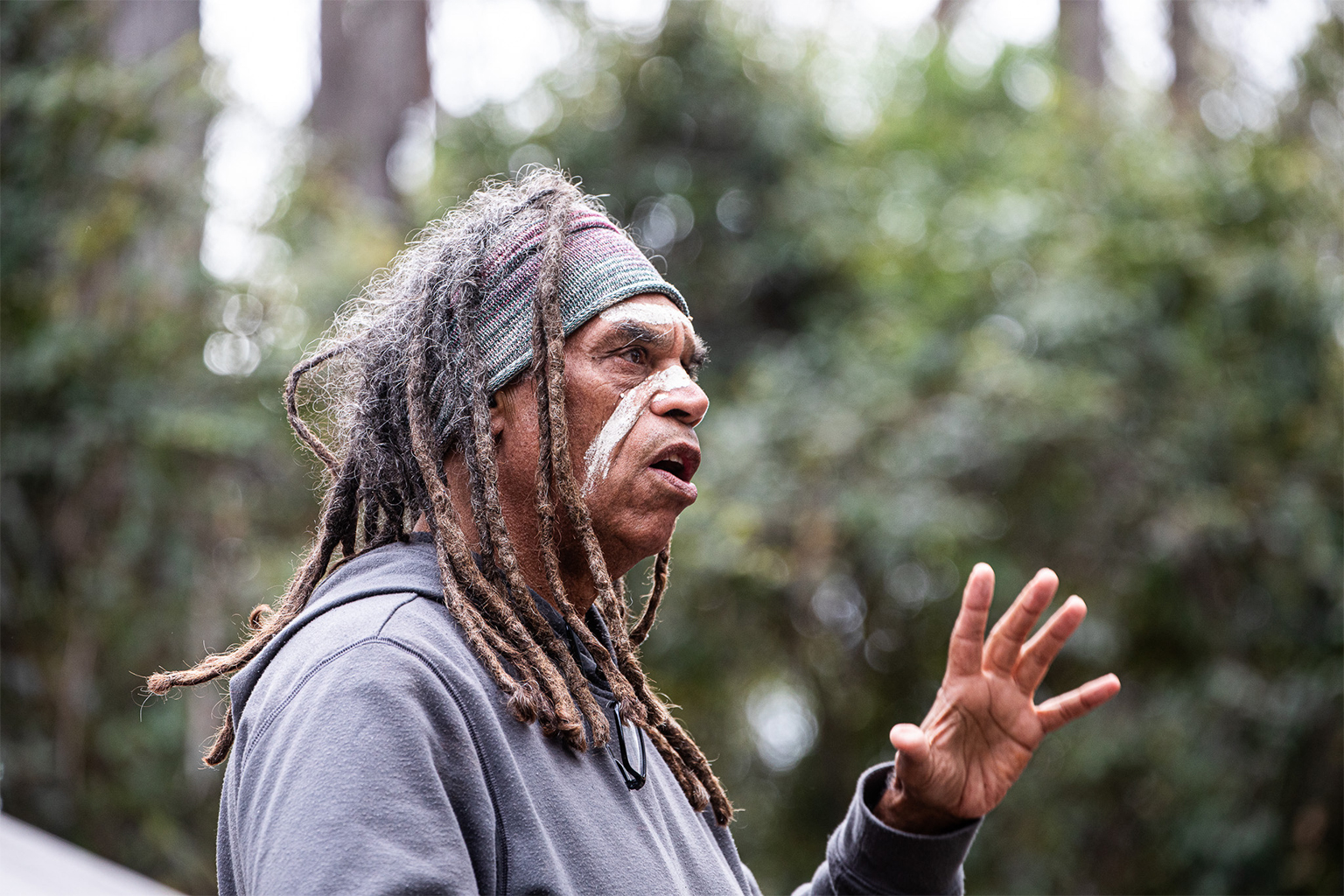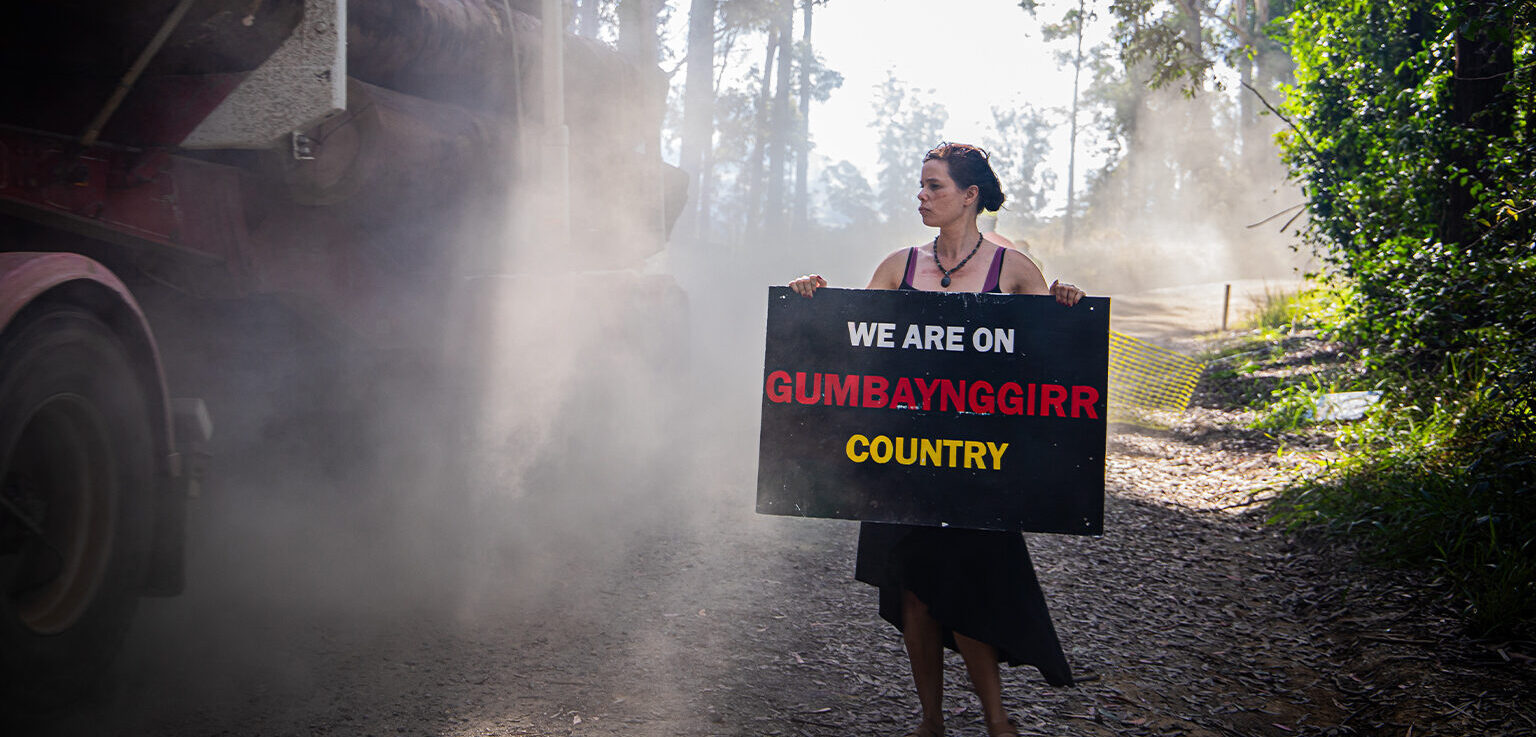What does land mean to Australia’s Indigenous groups fighting logging?
Oct 5, 2023
- Many Indigenous Gumbaynggirr people in Australia feel an intimate connection to their ancestral lands, which holds the trees, animals, ancestral spirits and creation stories that form a core part of their identity and sense of belonging.
- This landscape, part of the Newry State Forest in New South Wales, Australia, is facing a logging project by the state-owned Forestry Corporation that threatens the habitat of the vulnerable koala species — also a cultural totem.
- Gumbaynggirr protesters resisting logging plans say they believe every part of the world is in deep relationship with each other, including humans to nature and the land. Their cultural duty to protect totems, they say, pushes them to try to stop extractive industries.
- In this piece, Indigenous Gumbaynggirr protesters explain what land — this piece of the Earth — means to them.
BELLINGEN, Australia — A coastal breeze can be felt through the rustling eucalyptus leaves of blackbutt, ironbark and tallowwood trees in the old-growth native forest now known as Newry on the coast of the state of New South Wales, in present-day Australia.
A faint, melodic creaking sound is audible from a twisted grey gum tree swaying with the motion of the wind, sending a reminder to the Gumbaynggirr people that everything is alive and charged with spirits.
This is Gumbaynggirr Country, and it is home to the dunggiirr, the koala (Phascolarctos cinereus), one of the totem animals for the Gumbaynggirr people.
“The dunggiirr is a very powerful animal, their magic is very strong and the spirit of the Dunggiirr is respected,” says Sandy Greenwood, cultural consultant and member of the Gumbaynggirr people. Knowledge of dunggiirr, she tells Mongabay, has played a vital role in their creation stories, laws, customs, spirituality and identity.
As Greenwood expresses, many First Nations peoples in Australia feel an intimate and deeply profound, seemingly genetic connection, to their ancestral lands, often simply called “Country.”
“Generations of our ancestors have been a part of Country since creation time … and the animal spirits, the tree spirits, these are our ancestor totems — our family,” she says as a logging truck thunders past.

Here, where the grey gum tree creaks, Gumbaynggirr elders have been trying to protect these lands, known as Newry State Forest, since 2021 when it was earmarked for logging. Considering Australia is a resource-rich nation of coal and minerals, functioning on what were once sovereign nations, First Nations’ Country and sacred sites are regularly confronted with extractive industries.
During the current state Premier Christopher Minns’ election campaign, he promised to connect swaths of state forests on the mid-north coast to create the Great Koala National Park that would have protected these lands and the vulnerable marsupial species. But once sworn in, Newry was again approved for logging in May 2023.
By July 31, the state-owned New South Wales (NSW) Forestry Corporation had commenced industrial logging across an area of 2,500 hectares (more than 6,100 acres) in Newry State Forest. The NSW government did not respond to Mongabay’s request for a comment by the time of publication.
The timber harvested is often used for housing materials, has a lower carbon footprint than alternatives such as concrete or steel, will be regrown in the future and creates ongoing employment in the region, states the Forestry Corporation’s operation page.
“Koala habitat has been mapped across the landscape and Forestry Corporation compiles with strict rules that specify the number and type of koala feed trees to be protected in each area depending on the quality of the habitat,” the company tells Mongabay via email.
Considering relevant Gumbaynggirr elders or custodians say they were not consulted about the logging project, which is against the law, they took action the same day, setting up Camp Nunguu in cooperation with the local Bellingen Activist Network in order to resist what they see as the desecration of their sacred Country.
“We’ve been protecting Country since time immemorial … so I don’t even think about acting when it gets threatened; it’s not a rational thing, it’s a soul thing,” Greenwood says.

‘It’s our very essence’
For most non-Indigenous Australians and people living in global industrial hubs who are no longer rooted to a land, the value of land tends to be that of a marketable asset. For many local communities, land is also stability and a guarantee of survival that fulfills the basic human needs of having a place for shelter and acres to farm food.
For other communities, the relationship with land is becoming more commercial, either due to social changes or poverty, and younger generations are increasingly leaving their rural lands behind to move to urban areas. So, when a logging company comes to one’s land, some may begin negotiations to see how much money one can get in exchange or see if the deal is fair, even if there’s distaste about what’s happening in their backyard.
However, considering the inextricable link between First Nations protesters and Country, for them, the logging feels violent.
“I feel sick. … It’s very hard on my spirit. It’s colonial violence all over again,” says Greenwood, listing her ancestor’s experiences of discrimination and murder when loggers also moved in the area during the 1880s.
The cultural landscape of the forest reflects the Gumbaynggirr dreaming stories, which are their very essence and identity. So, when a company desecrates Country and forest, Indigenous protesters, who still feel rooted to the land, feel as if it’s desecrating their lineage, their DNA, their mother and father, Greenwood explains.
According to Michael Jarrett, a Gumbaynggirr original custodian, what is now Newry State Forest is home to a very sacred site called Nunguu Miiral.
The dreamtime story — a creation story, which relays the journeys of ancestors and their intricate knowledge and moral lessons that create the land, water and life; their Country — of Nunguu Miiral speaks of an eastern grey kangaroo (Macropus giganteus) that rested on top of the mountain to catch its breath.
As Jarrett says, an Indigenous hunter threw his boomerang as the kangaroo hopped down to the sea, cutting the head off and sending it with the body rolling down the mountain, turning the rocks permanently red and slippery. The blood was turned to gold and the rocks covered with moss; a warning not to venture and slip, causing possible injury or death.

In Gumbaynggirr culture, young men would come back to the top of this mountain after setting out as young boys for initiations, traveling and learning about their Country, learning the stories, the songs, the travel routes, tool-making, hunting techniques and kinship systems from elders.
“We believe that everything is in a relationship, with each other,” Jarrett expresses. “Plants, animals, people, water; everything is one big connection, and we are not separated from that, we are a part of the whole system.”
Through performing traditional ceremonies on Country, the life force of the land keeps going and the Earth becomes stronger, Jarrett explains. And when the Earth is nourished and flourishing, he says, so too are the people. It’s a form of interconnectedness and oneness.
“This is why Gumbaynggirr people try to respect the autonomy of everything and do not threaten the existence of anything,” he says.
However, not all people in First Nations groups in Australia maintain this same connection to Country. Historically, Indigenous people experienced the full effects of colonization and cultural changes, which meant a disconnection to Country and culture, says Greenwood, but in recent years more and more people are on the journey of reconnecting.
A cultural responsibility to the land
According to conservationists, the logging project threatens the critical habitat and food resources of the vulnerable koala — which is seen as kin to Jarrett — and so, too, it is threatening totems such as native yam (Dioscorea transversa), the spotted quoll (Dasyurus maculatus) and the greater glider (Petauroides volans). Totems are natural objects, like plants or animals, that an individual or group is responsible for. And when a people have a totem for thousands of years, the community has a cultural responsibility to make sure these totems are kept safe and that they flourish.
“If that entails going out into the forest to protest against logging that’s destroying the habitat of these koalas, that’s what I have to do,” Jarrett tells Mongabay. Even calling themselves traditional “custodians,” instead of owners of the land, reminds them of this duty. For these Indigenous Australians, they don’t own the land; the land owns them.

Alongside the Indigenous-led protest camp in Newry Forest, Jarrett applied for an injunction on Aug. 22 in the Land and Environment Court to stop logging amid alleged breaches of cultural heritage laws, and the proximity of logging to sacred cultural sites. During the protests, Indigenous people and allies alike chained themselves to logging trucks, delayed logging, began a ceremonial sacred fire and were subsequently arrested by police.
As a result of the injunction, NSW Forestry Corporation was forced to remove all machinery from the forest.
“My people had no say in what happened to their Country when a white man first came onto Gumbaynggirr homeland: They slaughtered my people, they took our land, they chopped down our trees, they desecrated our sacred places,” Jarrett says. “Now we can talk to people like environmental groups, lawyers, and say we want to fight for this country [and try] to use [their] law and turn it against them.”
On Sept. 12, the NSW government announced that logging across 106 hubs of “high value koala habitat” — including in Newry State Forest — would cease until plans to establish the promised Great Koala National Park are assessed.
However, these hubs cover only 5%, or 8,400 hectares of the 176,000 hectares (about 20,700 acres of the 435,000 acres) of forest originally proposed by the government in 2017 to protect, says the Nature Conservation Council and the country’s Green Party.
“We will win this when they stop … and put a ban … on logging in native forests, [and] we will be happy when they declare a Great Koala National Park,” Jarrett says.
According to Greenwood, it is important to protect Country and their culture for future generations, especially as their traditional knowledge can help inform biodiversity conservation efforts and climate change mitigation policies.
“The ancestral beings gave us our lore, our culture and taught us how to live in harmony with the land,” Greenwood says.
Banner image: Gumbaynggirr original custodian Michael Jarrett. Image courtesy of Bellingen Activist Network.
Indigenous-wildlife ranger collaboration conserves rare Australian rainforests
Related listening from Mongabay’s podcast: We speak with National Geographic photographer Kiliii Yuyan to talk about the value of traditional ecological knowledge (TEK) in protecting the world’s biodiversity and examples of TEK from Indigenous communities he’s visited. Listen here:
FEEDBACK: Use this form to send a message to the author of this post. If you want to post a public comment, you can do that at the bottom of the page.
Update: This article was updated with a comment by the Forestry Corporation on October 6, 2023.